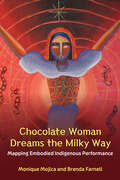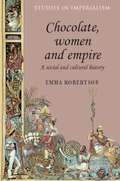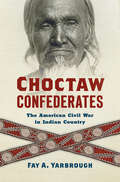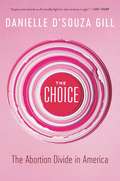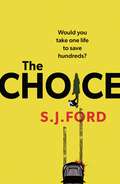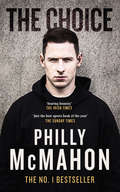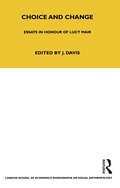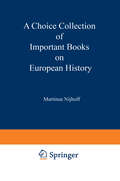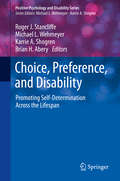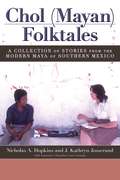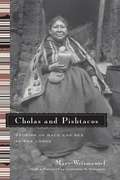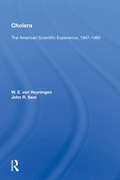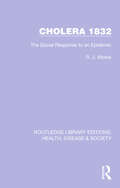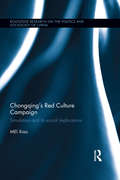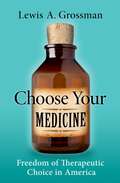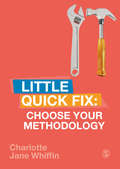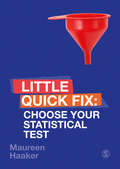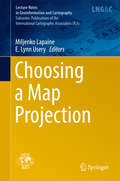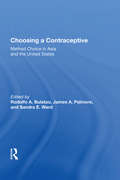- Table View
- List View
Chocolate Woman Dreams the Milky Way: Mapping Embodied Indigenous Performance (Theater: Theory/Text/Performance)
by Monique Mojica Brenda FarnellThis volume documents the creation of Chocolate Woman Dreams the Milky Way, a play written and performed by Monique Mojica with collaborators from diverse disciplines. Inspired by the pictographic writing and mola textiles of the Guna, an indigenous people of Panama and Colombia, the book explores Mojica’s unique approach to the performance process. Her method activates an Indigenous theatrical process that privileges the body in contrast to Western theater’s privileging of the written text, and rethinks the role of land, body, and movement, as well as dramatic story-structure and performance style. Co-authored with anthropologist Brenda Farnell, the book challenges the divide between artist and scholar, and addresses the many levels of cultural, disciplinary, and linguistic translations required to achieve this. Placing the complex intellect inherent to Indigenous Knowledges at its center, the book engages Indigenous performance theory, and concepts that link body, land, and story, such as terra nullius/corpus nullius, mapping, pattern literacy, land literacy, and movement literacy. Enhanced by contributions from other artists and scholars, the book challenges Eurocentric ideologies about what counts as “performance” and what is required from an “audience,” as well as long-standing body-mind dualisms.
Chocolate, women and empire: A social and cultural history (Studies in Imperialism #80)
by Emma RobertsonFrom Charlie and the Chocolate Factory to Chocolat, from romantic gift to guilty indulgence, chocolate has a special place in Western popular culture. But what are the hidden histories behind this luxurious commodity? This book examines chocolate production from cocoa bean to chocolate box, illuminating the dynamics of gender, race and empire which have structured the cocoa chain.Using a varied range of sources, and drawing on the author’s own relationship to the industry, this book reconnects the people and places at different stages of chocolate production. Emma Robertson stresses the need to recognise the complex histories of empire and labour which have made such pleasurable consumption possible. Chocolate, women and empire offers exciting new insights into the lives of women workers in a global industry. It will be invaluable to historians of British imperialism as well as to students of Women’s and Gender Studies, Cultural Studies and Business Studies.
Choctaw Confederates: The American Civil War in Indian Country
by Fay A. YarbroughWhen the Choctaw Nation was forcibly resettled in Indian Territory in present-day Oklahoma in the 1830s, it was joined by enslaved Black people—the tribe had owned enslaved Blacks since the 1720s. By the eve of the Civil War, 14 percent of the Choctaw Nation consisted of enslaved Blacks. Avid supporters of the Confederate States of America, the Nation passed a measure requiring all whites living in its territory to swear allegiance to the Confederacy and deemed any criticism of it or its army treasonous and punishable by death. Choctaws also raised an infantry force and a cavalry to fight alongside Confederate forces.In Choctaw Confederates, Fay A. Yarbrough reveals that, while sovereignty and states' rights mattered to Choctaw leaders, the survival of slavery also determined the Nation's support of the Confederacy. Mining service records for approximately 3,000 members of the First Choctaw and Chickasaw Mounted Rifles, Yarbrough examines the experiences of Choctaw soldiers and notes that although their enthusiasm waned as the war persisted, military service allowed them to embrace traditional masculine roles that were disappearing in a changing political and economic landscape. By drawing parallels between the Choctaw Nation and the Confederate states, Yarbrough looks beyond the traditional binary of the Union and Confederacy and reconsiders the historical relationship between Native populations and slavery.
The Choice: The Abortion Divide in America
by Danielle D'Souza GillFor fifty years the abortion debate has remained stagnant, trapped in sterile categories and familiar rhetoric. Each side thinks they know what the other has to say, so they don't listen. Consequently, they have become deaf to each other's pleas.Danielle D'Souza Gill, in a pathbreaking new book, blows the lid off the abortion debate, which is radically different than it was when the Supreme Court issued its landmark ruling of Roe v. Wade in 1973. Technology has transformed the landscape and allowed people to see development in the womb. Ultrasound has rendered many old assumptions about abortion obsolete.The Democratic Left has become radicalized on abortion. It is no longer a necessary evil, but a positive good. Consequently, the Left has legitimized a form of mass killing in this country that dwarfs the deaths caused by cancer, smoking, homicide, terrorism, and war.Writing with freshness, intelligence, and insight, Danielle explores the contours of the debate, taking into account new ideas, new technology, and new laws and putting forth a new vision for a life-affirming society.In Socratic style, Danielle builds her case in response to the strongest contentions of the pro-choice camp. She engages their most powerful arguments head-on, carefully examines them, and then dismantles them. The result is a pro-life argument so persuasive that it will reach into the heart of the most hardened opponent.While it is a heartbreaking book, it is in the end inspiring. No matter what you believe about abortion, this book will educate, astonish, and deeply move you. It may move you to a position different from what you now hold.If you read one book about abortion, make it this one, The Choice: The Abortion Divide in America.
The Choice: A Gripping And Addictive Crime Thriller
by SJ FordJane Bell is a murderer. At 4.55pm on 15th January, Jane Bell hit a man with her car, killing him instantly. With witnesses, CCTV footage and a signed confession, her guilt is never in doubt.Jane Bell is a hero. But she doesn't feel guilty. Because James Foster was about to blow up a primary school. He was planning on killing hundreds of children. He was going to kill her children.What would you have done? Readers love The Choice! 'Absolutely phenomenal... Fantastically written... Great characters, great details and a great ending!' Goodreads Reviewer, ?????'Wow, this book had me gripped from start to finish. As a mother myself I felt for Jane. Liked how the story was told from several of the characters' perspectives and had a few surprises that I wasn't expecting. Look forward to reading more from this author in the future' NetGalley Reviewer, ?????'It took me a while to write this review as I am speechless as how the book made me feel. It gripped me from the very first page... I felt a lot of emotions in this book... A powerful read. I thoroughly enjoyed it' Goodreads Reviewer, ?????'What an absolute page turner of a book. This is an utterly fantastic read. Is murder ever right????... Even to save a school full of children??... A fabulous book that I would highly recommend... It kept me going until the last page. Definitely a 5-star read' NetGalley Reviewer, ?????'Such an emotionally challenging story! Being a parent this challenged every bone of my morel fibre. I am Team Jane all the way!' NetGalley Reviewer, ?????'A dramatic suspense thriller... The choice she made for herself was terrifying for oneself but I found myself rooting for her and found it a enjoyable read' Goodreads Reviewer, ?????'What a brilliant, thought-provoking book. Book clubs will have a lot to talk about after reading this!... This book throws up so many questions and has you placing yourself into the protagonists' shoes like no other book I have ever read... Powerfully captivating, from beginning to end and one that you will never forget!' Inked Book Reviews, ?????'What a read... Well written keeping the reading gripped until the very end... An original story with great characters depth and a real life plot... Read it!!' NetGalley Reviewer, ?????'I was so invested in this dramatic thriller that I finished it over the course of a single night! The choice that the protagonist has to make is truly a terrifying one, but you can't help but root for her!' NetGalley Reviewer, ?????'Loved it, it really made you think about what you would do in the same situation, I thought the characters were very well drawn and when the story took an unexpected turn I wasn't sure what the final outcome would be. I will be recommending this book to everyone I know' NetGalley Reviewer, ?????'Truly wonderful and different... I was hooked till the last page. A first novel for this author, I can't wait for the next one' NetGalley Reviewer, ?????
The Choice
by Philly McMahonWhen Dublin footballer Philly McMahon lost his older brother John in 2012, it brought to an end a painful decade, during which John had slipped from the family circle into a deteriorating cycle of addiction. The effects were personally devastating, but amidst the loss there was a glimmer of hope, of opportunity, and what ultimately became the starting point for a journey of remarkable self-discovery.In this profound and inspirational memoir, McMahon traces his and John’s paths, from his earliest recollections of their childhood through the maelstrom of Ballymun’s heroin epidemic. He considers the relationships, tensions, arguments and chance occurrences that pushed them in very different directions: Philly to university, the boardroom and the hallowed turf of Croke Park; John to exile in London, heartbreak and, ultimately, tragedy.Raw, vivid and intensely moving, The Choice is many things – an epic story of triumph in the face of adversity and loss, a family saga, a tribute to the redemptive power of sport – but above all it’s a stirring meditation on the roles compassion and resilience can play in shaping our lives, and those around us, for the better.
Choice and Change: Essays in Honour of Lucy Mair (LSE Monographs on Social Anthropology)
by J. DavisThis volume in honour of Professor Mair reflects the range of her interests, and those of the Department in which she taught, in many areas of social anthropology, for it reports on research in Africa, Asia and the Mediterranean, on the tensions between tradition and modernity, between the individual and society, deviance and conformity, stability and conflict. The ambiguities of social change and the choices thus presented to individuals are examined in all the essays and issues of modem politics and development dominate most of them.
Choice and Change: Essays in Honour of Lucy Mair (LSE Monographs on Social Anthropology)
by John DavisThis volume in honour of Professor Mair reflects the range of her interests, and those of the Department in which she taught, in many areas of social anthropology, for it reports on research in Africa, Asia and the Mediterranean, on the tensions between tradition and modernity, between the individual and society, deviance and conformity, stability and conflict. The ambiguities of social change and the choices thus presented to individuals are examined in all the essays and issues of modem politics and development dominate most of them.
A Choice Collection of Important Books on European History: From the Stock of Martinus Nijhoff Bookseller
by Martinus NijhoffChoice, Preference, and Disability: Promoting Self-Determination Across the Lifespan (Positive Psychology and Disability Series)
by Michael L. Wehmeyer Karrie A. Shogren Roger J. Stancliffe Brian H. AberyThis book examines choice and preference in the lives of people with disability, focusing on people with intellectual and developmental disabilities. It provides an overview of choice and examines foundational concepts related to choice and preference, including self-determination and supported decision making. Chapters examine a range of critical service and policy issues, such as guardianship, individualized funding, the health care system, and the situation regarding choices for people with disability in international contexts. In addition, chapters explore issues ranging from the development of preference and choice in childhood to choices in older age and end of life matters. It provides in-depth analysis of particular choices faced at different points across the lifespan. The book concludes with implications for policy and practice. Topics featured in this book include:Supported decision making for adults with intellectual disabilities or acquired brain injury.The role of parents and families in the development of choice-making skills.Preference assessments for individuals who cannot tell us what they prefer.Employment opportunities for people with intellectual disabilities.Sexual and reproductive rights for people with intellectual disabilities.Disability and the choice to become a parent. Choice, Preference, and Disability is an essential resource for researchers, professors, clinicians, therapists, and other professionals as well as graduate students in the fields of developmental and positive psychology, rehabilitation, social work, special education, occupational, speech and language therapy, public health, and healthcare policy.
Chol (Mayan) Folktales: A Collection of Stories from the Modern Maya of Southern Mexico
by Nicholas A. Hopkins J. Kathryn JosserandChol (Mayan) Folktales deftly combines high-quality and thoughtfully edited transcriptions of oral storytelling with translation and narrative analysis, documenting and analyzing a trove of Chol folklore. The work provides a look into the folktale culture of the contemporary Maya presented with a rare and innovative theoretical framework. The rich Chol oral narrative tradition is represented by eleven stories, each printed in the original language of the storytellers with parallel English translations and accompanied by a brief introduction that provides the relevant cultural and mythological background. Included with eight of the stories is a link to an audio clip of the tale told aloud in the Chol language. In addition, Chol (Mayan) Folktales introduces a model for the analysis of narratives that can be used to demonstrate the existence of a tradition of storytelling applicable to other Maya lore, including Classic period hieroglyphic texts. Creating a nuanced sense of the Mayan oral tradition and revealing a highly structured literary style, this collection provides insight into contemporary Maya culture as well as a greater understanding of Classic period society. It will be of interest to students and scholars of folklore and literature and to anthropologists and linguists.
Cholas and Pishtacos: Stories of Race and Sex in the Andes (Women in Culture and Society)
by Mary WeismantelWinner of the 2003 Senior Book Prize from the American Ethnological Society. Cholas and Pishtacos are two provocative characters from South American popular culture—a sensual mixed-race woman and a horrifying white killerwho show up in everything from horror stories and dirty jokes to romantic novels and travel posters. In this elegantly written book, these two figures become vehicles for an exploration of race, sex, and violence that pulls the reader into the vivid landscapes and lively cities of the Andes. Weismantel's theory of race and sex begins not with individual identity but with three forms of social and economic interaction: estrangement, exchange, and accumulation. She maps the barriers that separate white and Indian, male and female-barriers that exist not in order to prevent exchange, but rather to exacerbate its inequality. Weismantel weaves together sources ranging from her own fieldwork and the words of potato sellers, hotel maids, and tourists to classic works by photographer Martin Chambi and novelist José María Arguedas. Cholas and Pishtacos is also an enjoyable and informative introduction to a relatively unknown region of the Americas.
Cholera: The American Scientific Experience 1947-1980
by W. E. van HeyningenCholera—the dehydration disease that can be fatal in just one or two days—has been one of mankind's most tenacious and enigmatic adversaries. Its well-documented history is the story of the vagaries of a disease that originated in the Ganges delta, where it causes annual epidemics, whose European incarnation is as old as the Battle of Waterloo, and which was responsible for six pandemics in the nineteenth century alone, three reaching the United States, claiming 300,000 lives altogether. This book records the role of U.S. medical science in the most recent—and finally successful—campaign against cholera. Drs. van Heyningen and Seal describe the first large-scale American research encounters with cholera, in Cairo in 1947 and in Bangkok in 1959. The authors then trace the growth in U.S. scientific and political interest in the eradication of cholera and describe the medical research and training facilities founded by the United States in Asia. There were failures as well as successes—exhaustive field trials of cholera vaccine proved ineffective—but eventually a simple oral treatment was found, and, in the process, advances were made toward the treatment of other dehydration diseases. The authors devote an entire chapter to the biochemistry underlying the physiology of cholera because its implications reach far beyond the disease itself and throw light on many aspects of normal and abnormal biochemistry. They also recall the debt of modern cholera research to earlier discoveries, which were too often neglected. This extraordinary history of one of the most important developments in medicine concludes with an account of how, with the emergence of the independent republic of Bangladesh, the U.S.-dominated cholera research laboratory was, with good will, transformed into a locally controlled international center for the study of diarrhoeal disease and related problems.
Cholera 1832: The Social Response to an Epidemic (Routledge Library Editions: Health, Disease and Society #20)
by R. J. MorrisOriginally published in 1976, this is the account of British society’s response to the threat of disease. It is the story of an administrative fight to exclude the disease by quarantine and to persuade commerce and working-class people to observe carefully thought-out regulations. The story of one of failure – of men hampered by lack of information, lack of resources and lack of a convincing scientific explanation. Medical science failed to see that infected water supplies were the major carriers of the epidemic and failed to acknowledge saline infusion (the basis of successful modern treatment) when it was presented to them by an obscure local surgeon in Leith. The social structure of the medical profession was as much a barrier to scientific advance as the technical limitations of statistical method and microscope. These reactions are explained in terms of the expectations and the understanding of those involved as well as in terms of modern medical knowledge and sociological theory.
Cholera 1832: The Social Response to an Epidemic (Routledge Library Editions: Health, Disease and Society #20)
by R. J. MorrisOriginally published in 1976, this is the account of British society’s response to the threat of disease. It is the story of an administrative fight to exclude the disease by quarantine and to persuade commerce and working-class people to observe carefully thought-out regulations. The story of one of failure – of men hampered by lack of information, lack of resources and lack of a convincing scientific explanation. Medical science failed to see that infected water supplies were the major carriers of the epidemic and failed to acknowledge saline infusion (the basis of successful modern treatment) when it was presented to them by an obscure local surgeon in Leith. The social structure of the medical profession was as much a barrier to scientific advance as the technical limitations of statistical method and microscope. These reactions are explained in terms of the expectations and the understanding of those involved as well as in terms of modern medical knowledge and sociological theory.
Cholera: The American Scientific Experience, 1947-1980
by W. E. van HeyningenCholera—the dehydration disease that can be fatal in just one or two days—has been one of mankind's most tenacious and enigmatic adversaries. Its well-documented history is the story of the vagaries of a disease that originated in the Ganges delta, where it causes annual epidemics, whose European incarnation is as old as the Battle of Waterloo, and which was responsible for six pandemics in the nineteenth century alone, three reaching the United States, claiming 300,000 lives altogether. This book records the role of U.S. medical science in the most recent—and finally successful—campaign against cholera. Drs. van Heyningen and Seal describe the first large-scale American research encounters with cholera, in Cairo in 1947 and in Bangkok in 1959. The authors then trace the growth in U.S. scientific and political interest in the eradication of cholera and describe the medical research and training facilities founded by the United States in Asia. There were failures as well as successes—exhaustive field trials of cholera vaccine proved ineffective—but eventually a simple oral treatment was found, and, in the process, advances were made toward the treatment of other dehydration diseases. The authors devote an entire chapter to the biochemistry underlying the physiology of cholera because its implications reach far beyond the disease itself and throw light on many aspects of normal and abnormal biochemistry. They also recall the debt of modern cholera research to earlier discoveries, which were too often neglected. This extraordinary history of one of the most important developments in medicine concludes with an account of how, with the emergence of the independent republic of Bangladesh, the U.S.-dominated cholera research laboratory was, with good will, transformed into a locally controlled international center for the study of diarrhoeal disease and related problems.
Chongqing’s Red Culture Campaign: Simulation and its Social Implications (Routledge Research on the Politics and Sociology of China)
by Xiao MeiBetween 2009 and 2012, the city of Chongqing came into the national, and even international spotlight, as it became the geographical centre of the ‘Singing Red, Smashing Black’ campaign, and later the political storm that swept China. Chongqing’s Red Culture Campaign drew an incredible amount of interest at the time, but speculation and prejudice has since blurred the public understanding of the sensational story that ties the campaign with the rise and fall of a political star, Bo Xilai. This book, therefore, seeks to study the nature of Chongqing’s Red Culture Campaign, and the interaction between the political programme and the practices of its participants. Based on fieldwork conducted in Chongqing, it seeks to question whether the Red Culture Campaign was actually a return to Maoist revolutionary mass campaigning whilst examining the relationship between the CCP's political power and the lives of the ordinary people as reflected in the case of the campaign. Ultimately, it highlights that the campaign was not in fact a real Maoist mass movement. Although it followed the pre-existing model of past mass campaigns in China, containing a series of frequent and highly performative operations, Xiao Mei argues that it essentially demonstrated critical features of ‘simulation’. By contributing to our understanding of the discrepancies between a designed political programme, and what it actually becomes when implemented on the ground, this book will be of use to students and scholars of Chinese Studies, Politics and Sociology.
Chongqing’s Red Culture Campaign: Simulation and its Social Implications (Routledge Research on the Politics and Sociology of China)
by Xiao MeiBetween 2009 and 2012, the city of Chongqing came into the national, and even international spotlight, as it became the geographical centre of the ‘Singing Red, Smashing Black’ campaign, and later the political storm that swept China. Chongqing’s Red Culture Campaign drew an incredible amount of interest at the time, but speculation and prejudice has since blurred the public understanding of the sensational story that ties the campaign with the rise and fall of a political star, Bo Xilai. This book, therefore, seeks to study the nature of Chongqing’s Red Culture Campaign, and the interaction between the political programme and the practices of its participants. Based on fieldwork conducted in Chongqing, it seeks to question whether the Red Culture Campaign was actually a return to Maoist revolutionary mass campaigning whilst examining the relationship between the CCP's political power and the lives of the ordinary people as reflected in the case of the campaign. Ultimately, it highlights that the campaign was not in fact a real Maoist mass movement. Although it followed the pre-existing model of past mass campaigns in China, containing a series of frequent and highly performative operations, Xiao Mei argues that it essentially demonstrated critical features of ‘simulation’. By contributing to our understanding of the discrepancies between a designed political programme, and what it actually becomes when implemented on the ground, this book will be of use to students and scholars of Chinese Studies, Politics and Sociology.
Choose Your Medicine: Freedom of Therapeutic Choice in America
by Lewis A. GrossmanA comprehensive history of the concept of freedom of therapeutic choice in the United States that presents a compelling look at how persistent but evolving notions of a right to therapeutic choice have affected American policy and law from the Revolution through the Trump Era. Throughout American history, lawmakers have limited the range of treatments available to patients, often with the backing of the medical establishment. The country's history is also, however, brimming with social movements that have condemned such restrictions as violations of fundamental American liberties. This fierce conflict is one of the defining features of the social history of medicine in the United States. In Choose Your Medicine, Lewis A. Grossman presents a compelling look at how persistent but evolving notions of a right to therapeutic choice have affected American health policy, law, and regulation from the Revolution through the Trump Era. Grossman grounds his analysis in historical examples ranging from unschooled supporters of botanical medicine in the early nineteenth century to sophisticated cancer patient advocacy groups in the twenty-first. He vividly describes how activists and lawyers have resisted a wide variety of legal constraints on therapeutic choice, including medical licensing statutes, FDA limitations on unapproved drugs and alternative remedies, abortion restrictions, and prohibitions against medical marijuana and physician-assisted suicide. Grossman also considers the relationship between these campaigns for desired treatments and widespread opposition to state-compelled health measures such as vaccines and face masks. From the streets of San Francisco to the US Supreme Court, Choose Your Medicine examines an underexplored theme of American history, politics, and law that is more relevant today than ever.
Choose Your Medicine: Freedom of Therapeutic Choice in America
by Lewis A. GrossmanA comprehensive history of the concept of freedom of therapeutic choice in the United States that presents a compelling look at how persistent but evolving notions of a right to therapeutic choice have affected American policy and law from the Revolution through the Trump Era. Throughout American history, lawmakers have limited the range of treatments available to patients, often with the backing of the medical establishment. The country's history is also, however, brimming with social movements that have condemned such restrictions as violations of fundamental American liberties. This fierce conflict is one of the defining features of the social history of medicine in the United States. In Choose Your Medicine, Lewis A. Grossman presents a compelling look at how persistent but evolving notions of a right to therapeutic choice have affected American health policy, law, and regulation from the Revolution through the Trump Era. Grossman grounds his analysis in historical examples ranging from unschooled supporters of botanical medicine in the early nineteenth century to sophisticated cancer patient advocacy groups in the twenty-first. He vividly describes how activists and lawyers have resisted a wide variety of legal constraints on therapeutic choice, including medical licensing statutes, FDA limitations on unapproved drugs and alternative remedies, abortion restrictions, and prohibitions against medical marijuana and physician-assisted suicide. Grossman also considers the relationship between these campaigns for desired treatments and widespread opposition to state-compelled health measures such as vaccines and face masks. From the streets of San Francisco to the US Supreme Court, Choose Your Medicine examines an underexplored theme of American history, politics, and law that is more relevant today than ever.
Choose Your Methodology: Little Quick Fix (Little Quick Fix)
by Charlotte WhiffinEstablishing methodological justification is a key precursor to undertaking research, whether you apply qualitative, quantitative or mixed methods. This new Little Quick Fix answers vital questions to put students onto the right track, such as: · What is methodology and what does it mean? · How does methodology differ from method? · What methodologies can you choose from? · When should you use qualitative, quantitative, or mixed methodology? · How can you use methodology to inform decisions about method? Working through the subject within an hour's read, this Little Quick Fix helps students to avoid diving into research before they've cleared up uncertainty and confusion, so that they can truly progress into the next step of their research project or dissertation.
Choose Your Statistical Test: Little Quick Fix (Little Quick Fix)
by Maureen HaakerLecturers teaching big mixed cohort intro statistics courses cite one of the more frequent challenges their students encounter involves choices over which statistical test to use. Students, even if they have a basic grasp of statistics and which types of tests are out there, often make the wrong choice, or have difficulty in distinguishing between the types of tests for different types of data. This Little Quick Fix provides step-by-step support in narrowing down possible tests they could use so they know which test fits their data and variables, and which test will actually help them answer the questions they want to answer and create maximum impact from their data. Little Quick Fix titles provide quick but authoritative answers to the problems, hurdles, and assessment points students face in the research course, project proposal, or design - whatever their methods learning is. Lively, ultra-modern design; full-colour, each page a tailored design. An hour's read. Easy to dip in and out of with clear navigation enables the reader to find what she needs - quick. Direct written style gets to the point with clear language. Nothing needs to be read twice. No fluff. Learning is reinforced through a 2-minute overview summary; 3-second summaries with super-quick Q&A DIY tasks create a work plan to accomplish a task, do a self-check quiz, solve a problem, get students to what they need to show their supervisor. Checkpoints in each section make sure students are nailing it as they go and support self-directed learning. How do I know I’m done? Each Little Quick Fix wraps up with a final checklist that allows the reader to self-assess they’ve got what they need to progress, submit, or ace the test or task.
Choosing a Map Projection (Lecture Notes in Geoinformation and Cartography)
by Miljenko Lapaine E. Lynn UseryThis book offers a much-needed critical approach to the intelligent use of the wide variety of map projections that are rapidly and inexpensively available today. It also discusses the distortions that are immanent in any map projection. A well-chosen map projection is one in which extreme distortions are smaller than those in any other projection used to map the same area and in which the map properties match its purpose. Written by leading experts in the field, including W. Tobler, F.C. Kessler, S.E. Battersby, M.P. Finn, K.C. Clarke, V.S. Tikunov, H. Hargitai, B. Jenny and N. Frančula. This book is designed for use by laymen. The book editors are M. Lapaine and E.L. Usery, Chair and Vice-Chair, respectively, of the ICA Commission on Map Projections for the period 2011-2015.
Choosing A Contraceptive: Method Choice In Asia And The United States
by Rodolfo A. BulataoThis book presents evidence from investigations of contraceptive method choice in a variety of countries, focusing on Asia and the United States. Included are discussions of psychosocial and economic approaches to understanding method choice and descriptive and statistical analyses of choices.
Choosing A Contraceptive: Method Choice In Asia And The United States
by Rodolfo A. Bulatao James A. Palmore Sandra E. WardThis book presents evidence from investigations of contraceptive method choice in a variety of countries, focusing on Asia and the United States. Included are discussions of psychosocial and economic approaches to understanding method choice and descriptive and statistical analyses of choices.
